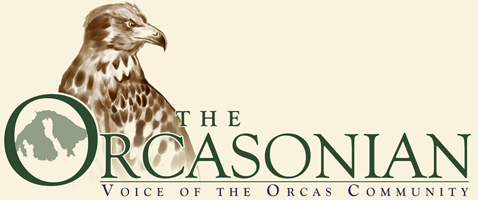— by Susan McBain, Orcas Issues reporter —
There was a lot of discussion of ambulances at the April 15 meeting of the Board of Fire Commissioners—specifically, buying one and fixing another.
The engine in Orcas Fire & Rescue’s (OIFR’s) newest ambulance, acquired in 2007, had a “catastrophic failure” over the weekend and will require replacement. The process will take about two weeks and cost around $20,000. OIFR has two backup ambulances, but those are even older, although still useful. The incident makes OIFR’s planned purchase of a new ambulance this year even more timely. Decisions on ordering and financing the new ambulance are nearly complete, and it should be in service before the end of the year. The repaired ambulance will then replace one of the older vehicles as a backup.
Another big topic was reorganization of the department’s administrative and front office tasks and staff. Commissioner Jim Helminski noted that the current organizational structure may not provide the most effective and efficient handling of the department’s many tasks under Chief Scott Williams. Helminski would like the commissioners and the Chief to look into current position descriptions, how other fire departments are organized and staffed, how various positions are compensated, and what changes in facilities and equipment might be needed. Commission Chair Tim Fuller observed that the process would need to be transparent and inclusive of various viewpoints, and that it could take up to a year to complete.
Emergency communications was a third topic of discussion. Chief Williams has talked to chiefs of the other island fire districts and to representatives of Codan Communications, which makes small antennas that could be added to existing equipment to greatly improve emergency communications on all the islands. Orcas, with its hilly terrain and many pockets of poor reception, would especially benefit. Williams hopes the chiefs can agree on their needs by June so that he can work with Codan on detailed pricing. He would like to see at least some implementation by year’s end. Commissioner Rick Christmas noted that “This is one of the most important things we need to do” for the emergency agencies in the islands, including fire, EMS, law enforcement, and public works.
Williams described the need for better data on walk-in patients. The Orcas Island Health Care District has asked for data on how many people come to the department in a given period, their reasons for coming, and the disposition of their cases. Tracking the data may be difficult because the department has two (soon to be three) software systems that can’t exchange data. Also, the department’s members will need training on how and why to collect the data. Williams wants to better understand the costs versus benefits of the effort.
Finally, two candidates for Secretary of the Commission attended the meeting and briefly described their qualifications. Two commissioners will meet with each one and make a recommendation soon.
The next Commission meeting is scheduled for Monday, May 20, at 5:30 p.m. in the Eastsound Fire Hall.
**If you are reading theOrcasonian for free, thank your fellow islanders. If you would like to support theOrcasonian CLICK HERE to set your modestly-priced, voluntary subscription. Otherwise, no worries; we’re happy to share with you.**








Wasn’t one reason for the OPALCO fiber backbone to eliminate all those many pockets of poor communications? We now have the fiber all done so why do we still have pockets of poor communication? Commissioner Christmas might want to check this out.
Sounds like a very productive meeting.. we have great volunteers, great staff, great paramedics who need Great Guidence.
Thank you all for your commitment and energy!!
Thanks Tom, for your comment, This is a Countywide effort which will provide a effective, efficient and affordable emergency communication network for all of us in the San Juans. The Codan system we are evaluating is designed to be the formal emergency communication system. The system is required to date stamp, record calls and reach virtually all areas of our community. The cellular systems in our County run on higher frequencies (i.e. 700 MHZ) and reach the majority of roads, businesses and homes in the county, though not everywhere required from an emergency perspective. The Codan system runs on lower frequency bands (for two-way radios) and uses OPALCO/Rock Island’s fiber backbone instead of bouncing around a ineffective microwave system. Using Opalco/Rock Island’s backbone fiber system saves our community 3/4 of the cost of the prior proposed microwave solution. I consider the Codan emergency communication system as essential for our islands and the final piece required to complete emergency communications county-wide…
Very exciting stuff….Stay tuned
Tom is correct about OPALCO’s promise that the OPALCO/Rock Island fiber and LTE would solve this emergency communications problem. In fact, it used this “fact” to convince the county council to allow OPALCO to permit all its LTE/commercial cell towers under a much more forgiving part of the county code than the one for cell towers, which these essentially are (thanks to T-Mobile’s deal). It was a lie, but one the council eagerly accepted and which the county planning department acceeded to, ignoring formal citizen complaints (which I know first-hand, having made one at the time). As a former EMT, I am glad someone is belatedly finding a solution to the problem OPALCO/Rock Island and the county council said would be solved with the cell towers. The chiefs should send the bill to OPALCO.
The OPALCO Board showed great leadership in the county to be willing to commit and invest in infrastructure to help solve the communication crisis in our county. Thanks to a successful effort and key partnerships, the county has been given the foundation for their individual component of the first-responder communication system. Note, all of the antenna installations and communication equipment locations proposed by CODAN leverages OPALCO/Rock Island pole sites and fiber infrastructure. As Rick stated, it has saved the county and ultimately its citizens millions in infrastructure costs needed to provide a solution. Another benefit of utilizing the existing grid and wireless sites is that it allows for a county-wide solution to bring a seamless communication system to all the agencies in our county. A huge improvement to the disconnected independent systems in place today. Better service and safety for our first-responders and members of our community.
Alan, No doubt having the system is a good thing. Using OPALCO electric’s infrastructure (that we already paid $20MM for) is another good thing.
To make things clearer, could you expand on the “millions” that it would have taken to do this without using OPALCO electric customers system? How many millions. For what infrastructure.